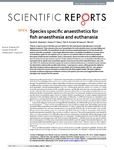Species specific anaesthetics for fish anaesthesia and euthanasia.
| dc.contributor.author | Readman, GD | en |
| dc.contributor.author | Owen, SF | en |
| dc.contributor.author | Knowles, TG | en |
| dc.contributor.author | Murrell, JC | en |
| dc.date.accessioned | 2017-10-09T15:52:59Z | |
| dc.date.available | 2017-10-09T15:52:59Z | |
| dc.date.issued | 2017-08-02 | en |
| dc.identifier.uri | http://hdl.handle.net/10026.1/10034 | |
| dc.description.abstract |
There is a need to ensure that the care and welfare for fish maintained in the laboratory are to the highest standards. This extends to the use of anaesthetics for both scientific study, humane killing and euthanasia at end of life. An anaesthetic should not induce negative behaviours and fish should not seek to avoid the anaesthetic. Surprisingly little information is available to facilitate a humane choice of anaesthetic agent for fish despite over 100 years of use and the millions of fish currently held in thousands of laboratories worldwide. Using a chemotaxic choice chamber we found different species specific behavioural responses among four closely related fish species commonly held in the laboratory, exposed to three widely used anaesthetic agents. As previously found for zebrafish (Danio rerio), the use of MS-222 and benzocaine also appears to induce avoidance behaviours in medaka (Oryzias latipes); but etomidate could provide an alternative choice. Carp (Cyprinus carpio), although closely related to zebrafish showed avoidance behaviours to etomidate, but not benzocaine or MS-222; and rainbow trout (Oncorhynchus mykiss) showed no avoidance to the three agents tested. We were unable to ascertain avoidance responses in fathead minnows (Pimephales promelas) and suggest different test paradigms are required for that species. | en |
| dc.format.extent | 7102 - ? | en |
| dc.language | eng | en |
| dc.language.iso | eng | en |
| dc.subject | Anesthesia | en |
| dc.subject | Anesthetics | en |
| dc.subject | Animals | en |
| dc.subject | Euthanasia | en |
| dc.subject | Fishes | en |
| dc.subject | Hydrogen-Ion Concentration | en |
| dc.subject | Solvents | en |
| dc.title | Species specific anaesthetics for fish anaesthesia and euthanasia. | en |
| dc.type | Journal Article | |
| plymouth.author-url | https://www.ncbi.nlm.nih.gov/pubmed/28769117 | en |
| plymouth.issue | 1 | en |
| plymouth.volume | 7 | en |
| plymouth.publication-status | Published online | en |
| plymouth.journal | Sci Rep | en |
| dc.identifier.doi | 10.1038/s41598-017-06917-2 | en |
| plymouth.organisational-group | /Plymouth | |
| plymouth.organisational-group | /Plymouth/Faculty of Science and Engineering | |
| plymouth.organisational-group | /Plymouth/REF 2021 Researchers by UoA | |
| plymouth.organisational-group | /Plymouth/REF 2021 Researchers by UoA/UoA06 Agriculture, Veterinary and Food Science | |
| dc.publisher.place | England | en |
| dcterms.dateAccepted | 2017-06-20 | en |
| dc.identifier.eissn | 2045-2322 | en |
| dc.rights.embargoperiod | Not known | en |
| rioxxterms.versionofrecord | 10.1038/s41598-017-06917-2 | en |
| rioxxterms.licenseref.uri | http://www.rioxx.net/licenses/all-rights-reserved | en |
| rioxxterms.licenseref.startdate | 2017-08-02 | en |
| rioxxterms.type | Journal Article/Review | en |


